Moderate overlap front: original test
Rating applies to 2007-13 models
Tested vehicle: 2009 Chevrolet Silverado 1500 LT Crew Cab 4x2
The Chevrolet Silverado 1500 and GMC Sierra 1500 were redesigned for the 2007 model year.
| Evaluation criteria | Rating |
|---|---|
| Overall evaluation | |
| Structure and safety cage | |
| Driver injury measures | |
| Head/neck | |
| Chest | |
| Leg/foot, left | |
| Leg/foot, right | |
| Driver restraints and dummy kinematics | |

Action shot taken during the frontal offset crash test.
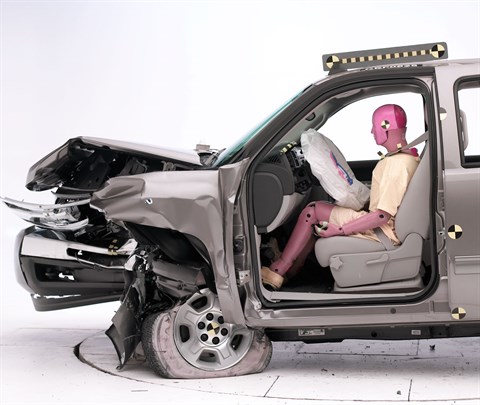
The dummy's position in relation to the steering wheel and instrument panel after the crash test indicates that the driver's survival space was maintained well.
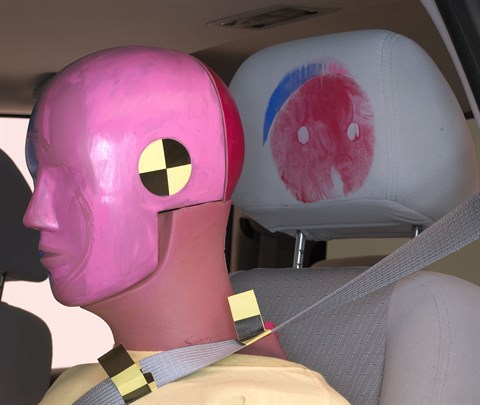
Dummy movement was well controlled. During rebound, the dummy's head hit only the head restraint, as indicated by smeared greasepaint.
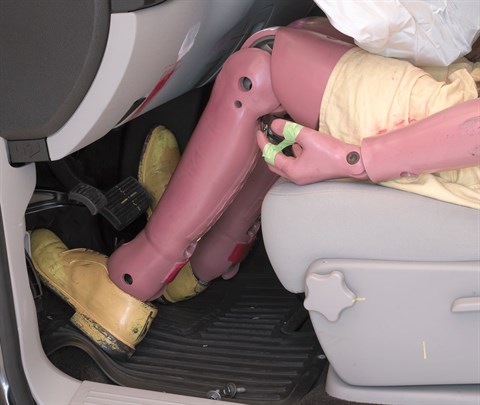
Forces on the lower left leg were high enough to indicate the possibility of injuries.
Measures of occupant compartment intrusion on driver side
| Evaluation criteria | Measurement |
|---|---|
| Test ID | CEF0825 |
| Footwell intrusion | |
| Footrest (cm) | 9 |
| Left (cm) | 11 |
| Center (cm) | 18 |
| Right (cm) | 14 |
| Brake pedal (cm) | 12 |
| Instrument panel rearward movement | |
| Left (cm) | 2 |
| Right (cm) | 2 |
| Steering column movement | |
| Upward (cm) | 6 |
| Rearward (cm) | 2 |
| A-pillar rearward movement (cm) | 3 |
Driver injury measures
| Evaluation criteria | Measurement |
|---|---|
| Test ID | CEF0825 |
| Head | |
| HIC-15 | 268 |
| Peak gs at hard contact | no contact |
| Neck | |
| Tension (kN) | 1.2 |
| Extension bending moment (Nm) | 29 |
| Maximum Nij | 0.28 |
| Chest maximum compression (mm) | 30 |
| Legs | |
| Femur force - left (kN) | 2.1 |
| Femur force - right (kN) | 2.3 |
| Knee displacement - left (mm) | 5 |
| Knee displacement - right (mm) | 6 |
| Maximum tibia index - left | 0.61 |
| Maximum tibia index - right | 0.74 |
| Tibia axial force - left (kN) | 4.6 |
| Tibia axial force - right (kN) | 3.6 |
| Foot acceleration (g) | |
| Left | 113 |
| Right | 76 |
Side: original test
Rating applies to 2007-09 models
Tested vehicle: 2009 Chevrolet Silverado 1500 LT Crew Cab 4x2 without optional side airbags
The Chevrolet Silverado 1500 and GMC Sierra 1500 were redesigned for the 2007 model year. Two tests of a 2009 Silverado 1500 were conducted, one with optional side airbags for the driver and rear passenger, and one without. These vehicles are rated separately, except that the structural ratings for both vehicles are based on both tests.
| Evaluation criteria | Rating |
|---|---|
| Overall evaluation | |
| Structure and safety cage | |
| Driver injury measures | |
| Head/neck | |
| Torso | |
| Pelvis/leg | |
| Driver head protection The dummy's head was hit by the window sill of the driver door. This impact did not produce high head injury measures, but the head protection is inadequate. |
|
| Rear passenger injury measures | |
| Head/neck | |
| Torso | |
| Pelvis/leg | |
| Rear passenger head protection Although the intruding barrier did not hit the dummy's head in this test, the head was not protected from contacts outside the vehicle. This indicates that only slightly different crash circumstances could produce a direct hit to a person's head. |
|
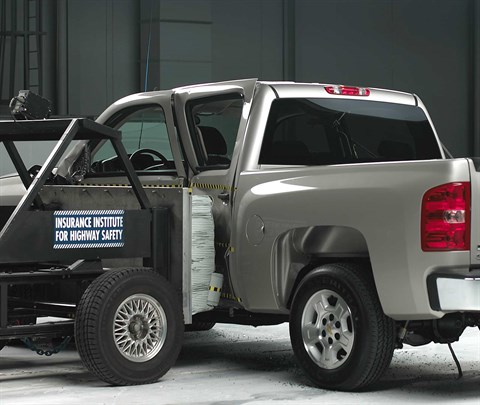
View of the vehicle and barrier just after the crash test.
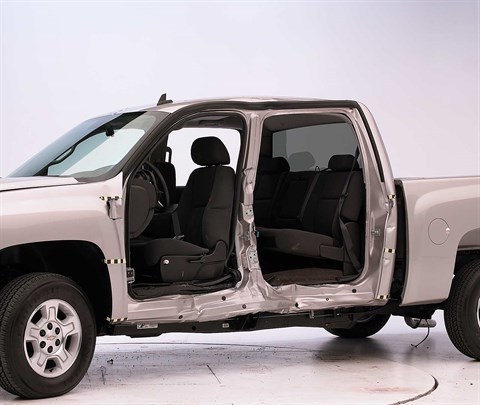
View of the vehicle after the crash with doors removed, showing the damage to the occupant compartment.
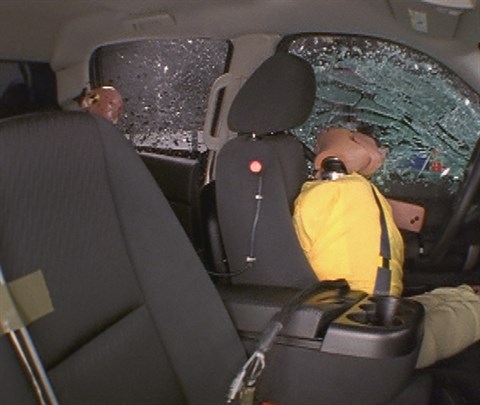
Action shot taken during the side impact crash test showing the driver dummy's head leaning well outward and approaching the window sill.
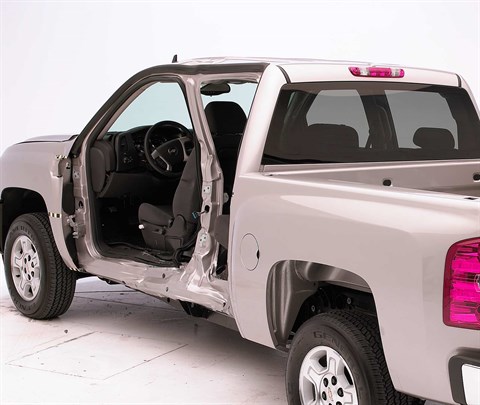
Intrusion of the B-pillar and door sill into the occupant compartment is apparent in this view.
Measures of occupant compartment intrusion on driver side
| Test ID | CES0856 | CES0903 |
|---|---|---|
| B-pillar to longitudinal centerline of driver's seat (cm) | 3.5 | 3.5 |
| Negative numbers indicate the amount by which the crush stopped short of the seat centerline. | ||
Driver injury measures
| Evaluation criteria | Measurement |
|---|---|
| Test ID | CES0856 |
| Head HIC-15 | 323 |
| Neck | |
| Tension (kN) | 2.4 |
| Compression (kN) | 0.0 |
| Shoulder | |
| Lateral deflection (mm) | 61 |
| Lateral force (kN) | 1.9 |
| Torso | |
| Maximum deflection (mm) | 58 |
| Average deflection (mm) | 45 |
| Maximum deflection rate (m/s) | 9.40 |
| Maximum viscous criterion (m/s) | 2.49 |
| Pelvis | |
| Iliac force (kN) | 1.4 |
| Acetabulum force (kN) | 4.9 |
| Combined force (kN) | 6.1 |
| Left femur | |
| L-M force (kN) | 0.5 |
| L-M moment (Nm) | 102 |
| A-P moment (Nm) | 39 |
Passenger injury measures
| Evaluation criteria | Measurement |
|---|---|
| Test ID | CES0856 |
| Head HIC-15 | 65 |
| Neck | |
| Tension (kN) | 1.1 |
| Compression (kN) | 0.2 |
| Shoulder | |
| Lateral deflection (mm) | 21 |
| Lateral force (kN) | 1.2 |
| Torso | |
| Maximum deflection (mm) | 56 |
| Average deflection (mm) | 31 |
| Maximum deflection rate (m/s) | 4.67 |
| Maximum viscous criterion (m/s) | 1.38 |
| Pelvis | |
| Iliac force (kN) | 0.1 |
| Acetabulum force (kN) | 1.3 |
| Combined force (kN) | 1.3 |
| Left femur | |
| L-M force (kN) | 1.0 |
| L-M moment (Nm) | 178 |
| A-P moment (Nm) | 28 |
Rating applies to 2007-09 models
Tested vehicle: 2009 Chevrolet Silverado 1500 LT Crew Cab 4x2 with optional front and rear head curtain airbags
The Chevrolet Silverado 1500 and GMC Sierra 1500 were redesigned for the 2007 model year. Two tests of a 2009 Silverado 1500 were conducted, one with optional side airbags for the driver and rear passenger, and one without. These vehicles are rated separately, except that the structural ratings for both vehicles are based on both tests.
| Evaluation criteria | Rating |
|---|---|
| Overall evaluation | |
| Structure and safety cage | |
| Driver injury measures | |
| Head/neck | |
| Torso | |
| Pelvis/leg | |
| Driver head protection | |
| Rear passenger injury measures | |
| Head/neck | |
| Torso | |
| Pelvis/leg | |
| Rear passenger head protection | |
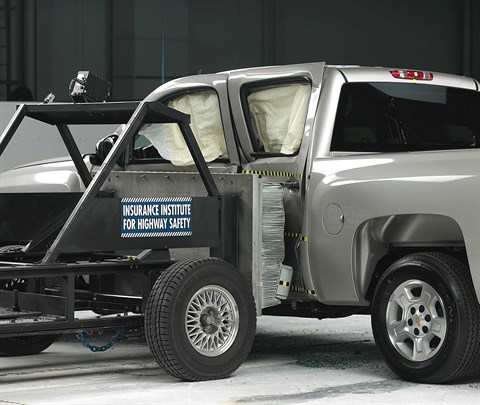
View of the vehicle and barrier just after the crash test.

View of the vehicle after the crash with doors removed, showing the side airbag and damage to the occupant compartment.
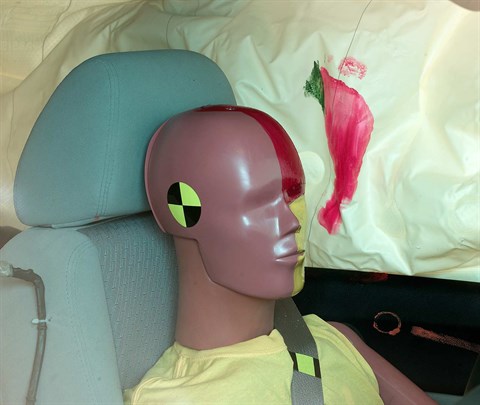
Smeared greasepaint shows where the driver dummy's head was protected from being hit by hard structures by the side airbag.

Smeared greasepaint shows where the rear passenger dummy’s head was protected by the side airbag.
Measures of occupant compartment intrusion on driver side
| Test ID | CES0856 | CES0903 |
|---|---|---|
| B-pillar to longitudinal centerline of driver's seat (cm) | 3.5 | 3.5 |
| Negative numbers indicate the amount by which the crush stopped short of the seat centerline. | ||
Driver injury measures
| Evaluation criteria | Measurement |
|---|---|
| Test ID | CES0903 |
| Head HIC-15 | 456 |
| Neck | |
| Tension (kN) | 2.3 |
| Compression (kN) | 0.1 |
| Shoulder | |
| Lateral deflection (mm) | 48 |
| Lateral force (kN) | 2.0 |
| Torso | |
| Maximum deflection (mm) | 52 |
| Average deflection (mm) | 39 |
| Maximum deflection rate (m/s) | 9.96 |
| Maximum viscous criterion (m/s) | 1.82 |
| Pelvis | |
| Iliac force (kN) | 1.7 |
| Acetabulum force (kN) | 3.5 |
| Combined force (kN) | 5.0 |
| Left femur | |
| L-M force (kN) | 0.7 |
| L-M moment (Nm) | 110 |
| A-P moment (Nm) | 25 |
Passenger injury measures
| Evaluation criteria | Measurement |
|---|---|
| Test ID | CES0903 |
| Head HIC-15 | 84 |
| Neck | |
| Tension (kN) | 0.7 |
| Compression (kN) | 0.2 |
| Shoulder | |
| Lateral deflection (mm) | 17 |
| Lateral force (kN) | 1.1 |
| Torso | |
| Maximum deflection (mm) | 54 |
| Average deflection (mm) | 29 |
| Maximum deflection rate (m/s) | 4.92 |
| Maximum viscous criterion (m/s) | 1.26 |
| Pelvis | |
| Iliac force (kN) | 0.0 |
| Acetabulum force (kN) | 1.3 |
| Combined force (kN) | 1.3 |
| Left femur | |
| L-M force (kN) | 1.0 |
| L-M moment (Nm) | 200 |
| A-P moment (Nm) | 37 |
Head restraints & seats
Seat type: Manual cloth seats
| Overall evaluation | |
|---|---|
| Dynamic rating | |
| Seat/head restraint geometry |
| Seat type | Manual cloth seats |
|---|---|
| Geometry | |
| Backset (mm) | 62 |
| Distance below top of head (mm) | 42 |
| Seat design parameters | |
| Pass/fail | Pass |
| Max T1 acceleration (g) | 9.1 |
| Head contact time (ms) | 87 |
| Force rating | 2 |
| Neck forces | |
| Max neck shear force (N) | 183 |
| Max neck tension (N) | 528 |
About the head restraint & seat test
Currently, IIHS tests apply only to front seats.